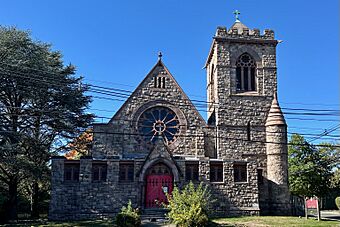Grace Episcopal Church (Plainfield, New Jersey) facts for kids
Quick facts for kids |
|
|
Grace Church or Grace Episcopal Church
|
|

Seventh Street entrance
|
|
| Location | 600 Cleveland Avenue Plainfield, New Jersey |
|---|---|
| Area | 1.7 acres (0.69 ha) |
| Built | 1892 |
| Architect | Robert W. Gibson; Charles Wilson; et al. |
| Architectural style | Gothic Revival |
| NRHP reference No. | 02000106 |
| Added to NRHP | May 10, 2002 |
Grace Church, also known as Grace Episcopal Church, is a beautiful old church in Plainfield, New Jersey. You can find it at 600 Cleveland Avenue. This church is very special because of its amazing architecture, art, and music. Because of its importance, it was added to the National Register of Historic Places on May 10, 2002. This means it's recognized as a significant historical place in the United States.
Contents
The Story of Grace Church
How the Church Began
The church's journey started on April 18, 1853, when it was first known as St. Mary's Episcopal Church. Just three months later, they laid the first stone for their church building. This first church was built on East Front Street in Plainfield, on land given to them as a gift. The building was finished by the early autumn of that year.
Moving to a New Home
Over the next ten years, more and more people joined the church. The original building became too small for everyone! So, the church bought a new piece of land in a fancy part of town, at what is now Cleveland Avenue. They decided to move their entire church building to this new spot. The old building was carefully taken apart and rebuilt at the new location during the summer of 1876. The first service in their "new" old building happened on October 15, 1876.
Building a Grand New Church
As Plainfield grew into a busy town where many people lived and commuted, the church realized they needed an even bigger building. They wanted a church that could serve the growing community. They chose a famous architect named Robert W. Gibson to design their new church. He had also designed several important buildings in New York City. Gibson designed Grace Church in the Gothic-Revival style. This means it looks like the grand churches built in Europe many centuries ago. It was built with stone and had beautiful carved red sandstone details.
Amazing Architecture
Laying the Cornerstone
The first stone for the new Grace Church was laid on May 5, 1891. The very first church service in this brand-new building took place on April 17, 1892. The design and craftsmanship of Grace Church show the amazing church architecture of the late 1800s.
Inside the Church
The church building has two floors and is shaped like a cross when you look at it from above. This is called a cruciform plan. It's a classic Gothic Revival style, which means it has cool features like pointed windows and arches. You can also see decorative sandstone carvings around the doors and windows. Inside, there's a main walkway called a nave, with narrower aisles on each side. High windows above the aisles, called Clerestory windows, let lots of light into the church.
Special Areas and Details
In the south part of the church, there's a special chapel. It was dedicated in 1966 and is called the Chapel of Christ the King. It's a memorial to Walter C. Scott. The church also has a beautiful pulpit made of white oak. It was dedicated in 1964 in memory of Dorothy Fleming Waring. On the pulpit, you can see carvings of the Four Evangelists: Matthew, Mark, Luke, and John. These carvings were made in Italy, and each figure has a symbol of their Gospel at their feet.
The Parish House
The Parish House was built in 1905. It's a busy place with lots of rooms! On the second floor, there are six classrooms and two offices. Downstairs, on the lower level, you'll find five more classrooms, a small gym, and offices for Plainfield Community Outreach. There's also the Choirmaster's Office and the Choir room. The main floor has the All Saints Chapel, a meeting room for the church leaders (called the Vestry Meeting Room), and a parlor that connects to the kitchen. At one end of the hallway, there's a large assembly hall named after Dr. Harry James Knickle, who was the ninth rector (head priest) of the church. At the other end of the main floor, leading into the church, are the Church office and the Rector's Office.
Ackerman Memorial Garden
The Ackerman Memorial Garden is a peaceful spot that was dedicated on Sunday, May 18, 1969. This garden was a gift from the Ackerman sons, given in memory of their parents. Their parents were very dedicated and faithful members of Grace Church for their whole lives. Today, the garden is filled with flowers that attract many different butterflies, so it's often called "the Butterfly Garden." Church members can even choose to have their ashes buried in this beautiful garden.
See also




